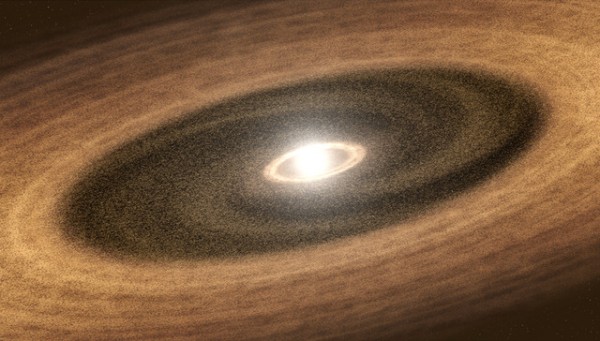For the First Time Ever, Scientists Witness Birth of Three New Planets
| Ana Verayo | | Nov 19, 2015 07:28 AM EST |
(Photo : NASA/JPL-Caltech) The birth of three new planets is captured for the first time inside the protoplanetary disk of LkCa 15.
Astronomers are now directly observing and witnessing how planets are being born, for the first time ever, where scientists have captured a gas giant exoplanet that is in the process of forming around a young star known as LkCa 15, some 450 light years away.
Like Us on Facebook
According to co-lead author of the study, Kate Follette from the Stanford University, this is really exciting, as these are the first captured images of planets that are forming directly. This evidence can provide an opportunity to monitor a system in the future and to gain a better understanding of how planets are created.
The star system of the LkCa 15 contains a large disk made from interstellar dust and gas that are enshrouding this young star, similar to our sun, which is only 2 million years old. These circumstellar disks usually encircle newborn stars, which are actually raw stellar material that are used to form planets.
Prior studies already detected these large gaps in these disks which indicate new worlds that are in the process of clearing out. These disks can also contain heat signatures that suggest evidence of exoplanets inside these gaps.
In LkCa 15's disk, there's a gap inside and also, a giant protoplanet candidate called LkCa 15b that was identified in 2012, with a distance of 16 astronomical units from its star. One astronomical unit equals to the distance of Earth from the sun or, 93 million miles.
In this new study, the team identified and confirmed LkCA 15b by imaging it via hydrogen alpha photons which is a type of light that emits superheated material from the accretion process of a new world.
Apart from LkCA 15b, observations also reveal the presence of other exoplanets, which are LkCA 15c inside this gap and another one called LkCA 15d. Follette confirms that this is the first time ever that evidence links a forming planet to a gap inside a protoplanetary disk.
This new study is published in the journal Nature.
Tagsscientists capture witness observe planets forming, scientists observing birth of planets, planet formation, birth of planets, Exoplanets, birth new planet first time, LkCa 15, protoplantetary disk, protoplanet, exoplanet
©2015 Chinatopix All rights reserved. Do not reproduce without permission
EDITOR'S PICKS
-

Did the Trump administration just announce plans for a trade war with ‘hostile’ China and Russia?
-

US Senate passes Taiwan travel bill slammed by China
-

As Yan Sihong’s family grieves, here are other Chinese students who went missing abroad. Some have never been found
-

Beijing blasts Western critics who ‘smear China’ with the term sharp power
-

China Envoy Seeks to Defuse Tensions With U.S. as a Trade War Brews
-

Singapore's Deputy PM Provides Bitcoin Vote of Confidence Amid China's Blanket Bans
-

China warns investors over risks in overseas virtual currency trading
-

Chinese government most trustworthy: survey
-

Kashima Antlers On Course For Back-To-Back Titles
MOST POPULAR
LATEST NEWS
Zhou Yongkang: China's Former Security Chief Sentenced to Life in Prison

China's former Chief of the Ministry of Public Security, Zhou Yongkang, has been given a life sentence after he was found guilty of abusing his office, bribery and deliberately ... Full Article
TRENDING STORY

China Pork Prices Expected to Stabilize As The Supplies Recover

Elephone P9000 Smartphone is now on Sale on Amazon India

There's a Big Chance Cliffhangers Won't Still Be Resolved When Grey's Anatomy Season 13 Returns

Supreme Court Ruled on Samsung vs Apple Dispute for Patent Infringement

Microsoft Surface Pro 5 Rumors and Release Date: What is the Latest?










